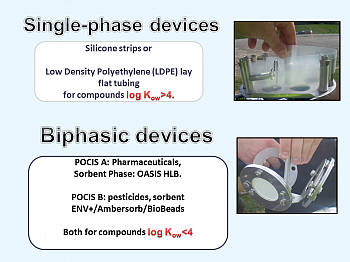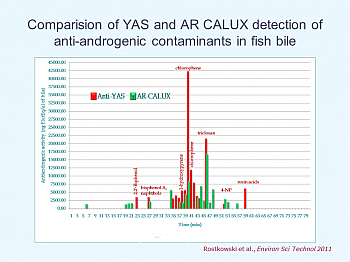The widespread occurrence of feminized male fish downstream of discharge from UK wastewater treatment works (WwTWs) has led to substantial interest from environmental biologists, government organizations, and industry. The phenomenon of feminized fish has further been observed in freshwater and marine environments throughout the world. Feminized responses include the formation of the egg-yolk precursor, vitellogenin, within male and juvenile animals as well as histopathological changes in reproductive organs such as testes-ova and reductions in sperm count and motility. These effects have been attributed to exposure to environment estrogens, particularly steroidal estrogens present in WwTWs effluents. However, UK WwTWs can contain high levels of antiandrogenic activity as well as estrogenic activity. It is possible that antiandrogens, by blocking normal male development, may act together with estrogenic agents to feminize fish and other biota in the aquatic environnment.
There are many different chemical structures that can interact with the androgen receptor and block the action of natural androgens such as testosterone and its metabolites. Hence, it is not possible to predict the types of chemicals in contaminated waters that could act as antiandrogens. We use effect-directed analyses to identify antiandrogenic structures by combining androgen receptor screening with mass spectrometry analyses of fractionated the water extracts to determine the likely receptor active structures present in the environment.
DIESE Interreg IV project and the identification of of antiandrogens in coastal sediments.
We have used effects- directed analyses to identify antiandrogenic contaminants in coastal sediments in southern UK and northern France. Over 100 sites were surveyed and revealed high antiandrogenic activity in areas of shipping activity. The major contaminants appear to be polycyclic aromatic compounds and their metabolites. The work is reported in the DIESE final project report and is published in a special edition of the Marine Pollution Bulletin.
Passive sampling and identification of environmental antiandrogens in surface waters

We have compared the efficiency of both single phase and biphasic POCIS samplers to extract antiandrogenic compounds from surface waters below discharges of wastewater effluents. As part of an EU Marie Curie fellowship, Dr Camilla Liscio has used an effect-directed analytical approach to identify the main antiandrogens in river water. Over 40 different structures were detected, but the most potent antiandrogenic contaminants were fungicides and disinfectant products. The work is published in Water Research 2014.
Bioavailable antiandrogens.
 In this study, we collborated with Prof C Tyler's group at the University of Exeter to identify bioavailable antiandrogenic contaminants in bile of fish exposed to WwTW effluents. Bile extracts were fractionated by HPLC and profiled for antiandrogen activity using yeast (anti-YAS) and mammalian based (AR-CALUX) androgen receptor transcription screens. The predominant fractions with AA activity in both androgen receptor screens contained the germicides chlorophene and triclosan, and together these contaminants accounted for 51% of the total anti-YAS activity in the fsh bile. Other antiandrogens identifed in bile included chloroxylenol, dichlorophene, resin acids, napthols, oxybenzone, 4-nonylphenol, and bisphenol A. Pure standards of these compounds were active in the androgen receptor screens at potencies relative to flutamide ( a standard antiandrogen) of between 0.1 and 13.0. Thus, we have identified, for the first time, a diverse range of antiandrogenic chemicals in effluents that are bioavailable to fish. These structures are currently being assessed for their risk to the reproductive health of fish by the Exeter group. For further information see Rostkowski et al, 2011.
In this study, we collborated with Prof C Tyler's group at the University of Exeter to identify bioavailable antiandrogenic contaminants in bile of fish exposed to WwTW effluents. Bile extracts were fractionated by HPLC and profiled for antiandrogen activity using yeast (anti-YAS) and mammalian based (AR-CALUX) androgen receptor transcription screens. The predominant fractions with AA activity in both androgen receptor screens contained the germicides chlorophene and triclosan, and together these contaminants accounted for 51% of the total anti-YAS activity in the fsh bile. Other antiandrogens identifed in bile included chloroxylenol, dichlorophene, resin acids, napthols, oxybenzone, 4-nonylphenol, and bisphenol A. Pure standards of these compounds were active in the androgen receptor screens at potencies relative to flutamide ( a standard antiandrogen) of between 0.1 and 13.0. Thus, we have identified, for the first time, a diverse range of antiandrogenic chemicals in effluents that are bioavailable to fish. These structures are currently being assessed for their risk to the reproductive health of fish by the Exeter group. For further information see Rostkowski et al, 2011.


